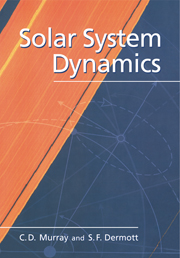Book contents
- Frontmatter
- Contents
- Preface
- 1 Structure of the Solar System
- 2 The Two-Body Problem
- 3 The Restricted Three-Body Problem
- 4 Tides, Rotation, and Shape
- 5 Spin–Orbit Coupling
- 6 The Disturbing Function
- 7 Secular Perturbations
- 8 Resonant Perturbations
- 9 Chaos and Long-Term Evolution
- 10 Planetary Rings
- Appendix A Solar System Data
- Appendix B Expansion of the Disturbing Function
- References
- Index
8 - Resonant Perturbations
Published online by Cambridge University Press: 05 June 2012
- Frontmatter
- Contents
- Preface
- 1 Structure of the Solar System
- 2 The Two-Body Problem
- 3 The Restricted Three-Body Problem
- 4 Tides, Rotation, and Shape
- 5 Spin–Orbit Coupling
- 6 The Disturbing Function
- 7 Secular Perturbations
- 8 Resonant Perturbations
- 9 Chaos and Long-Term Evolution
- 10 Planetary Rings
- Appendix A Solar System Data
- Appendix B Expansion of the Disturbing Function
- References
- Index
Summary
The heavens themselves, the planets, and this centre
Observe degree, priority, and place,
Insisture, course, proportion, season, form,
Office, and custom, in all line of order.
William Shakespeare, Troilus and Cressida, I, iiiIntroduction
We saw in Chapter 6 how resonant effects arise in the small divisor problem when we considered the motion of an asteroid whose orbital period was a simple fraction of Jupiter's period. The naïve theory predicted that, as the ratio of mean motions approached the exact resonant value, the small divisor approached zero and large-amplitude variations in the elements would result. In this chapter we examine the theory of resonance in more detail. Starting from simple geometrical and physical approaches, we go on to show how the simple model breaks down. In order to understand the basic dynamics of resonance we start by using the pendulum approach valid for resonant phenomena in the asteroid belt. We then give a complete and detailed model of resonance using a Hamiltonian approach. Throughout this chapterwedevelop a variety of approaches to handle the problem of orbit–orbit resonance in the solar system and beyond.
Although there is an extensive range of literature on celestial mechanics, there is little devoted specifically to the theory of resonance. Useful reviews of the subject, particularly in the context of orbital evolution through resonance, have been given by Greenberg (1977), Peale (1986), and Malhotra (1988).
- Type
- Chapter
- Information
- Solar System Dynamics , pp. 321 - 408Publisher: Cambridge University PressPrint publication year: 2000
- 1
- Cited by

